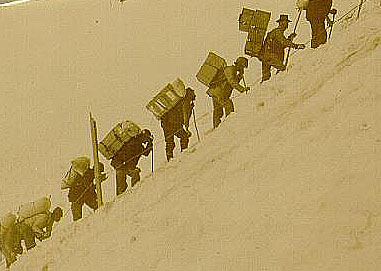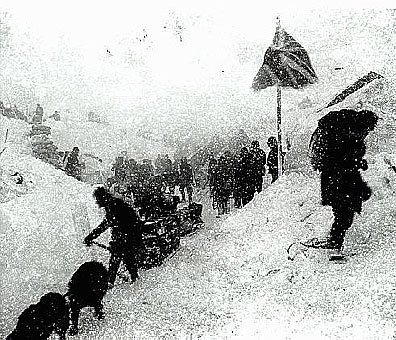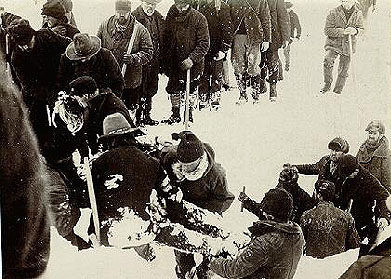Chilkoot Pass: The "Golden Staircase"
"It was a super-human effort to transport those thousands of pounds up that narrow, slippery, rocky trail of the Pass, through boulder-strewn canyons, across swampy bottomlands."
~ Martha Louise Black, Stampeder.

The twenty-six mile trail over Chilkoot Pass was steep and hazardous. Most stampeders who gave up did so attempting to cross the mountains.
In the winter, stampeders struggled in blizzards, snow, frigid temperatures, and avalanches. The trail shot up about 1,000 feet in the final half mile. Stampeders climbed the "golden staircase," 1,500 steps cut in the snow and ice, and used a guide rope for support. Circa 1898.
~ Detail from Cantwell 33.
Stampeders stacked outfits at the summit near the Canadian customs house where storms often raged. The Canadian flag in the background marks the international boundary line. 1898.
~ Detail from Hegg 108.


Stampeders recovered the injured and dead from an avalanche near the summit that killed 63 people on April 3, 1898.
~ Detail from LaRoche photo 2130.
Travelers did not always fare better in the summer. Stampeders struggled in rain, fog, boulders, and bogs. Without its covering of snow and ice, the trail to the summit led over giant boulders over which people literally crawled.
To move one outfit over the pass, stampeders packed and cached their goods up to forty times and hiked up to 1,000 miles. The terrain on the last four miles of the trail was too rough for pack animals. Discarded supplies littered the trail as stampeders cast unnecessary items aside. Many took three months to move their goods from Dyea to the summit.
Stampeders who could pay high fees relied on Chilkat, Chilkoot, and Stikine Indian packers. Stampeders short of funds also worked as packers.
Packers near Chilkoot summit. 1897.
~ Detail from LaRoche 2035.